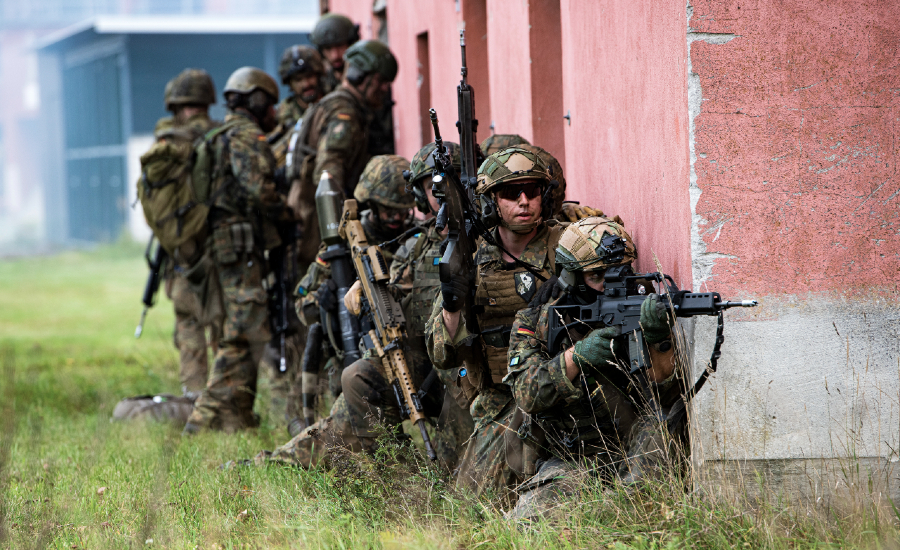Europe After the Ukraine War
Europe is anticipating a world in which Russia is weaker but no less dangerous.

Published by The Lawfare Institute
in Cooperation With

Editor’s Note: Russia’s invasion of Ukraine has generated a massive backlash that is likely to endure even if the guns fall silent. RAND Corporation’s Raphael Cohen examines the longer-term implications for Europe, assessing how it will affect European energy policy, military preparedness and overall unity.
Daniel Byman
***
With the bombs still falling on Kyiv and Russia slowly expanding its control over the south, the outcome of the war in Ukraine is anything but certain. And yet, one thing is clear: The war in Ukraine will be a watershed historical event. Four macro-levels trends, in particular, are upending the strategic balance in Europe. Russia will likely emerge weaker but, perhaps, no less dangerous; by contrast, Europe will likely become stronger militarily, less energy dependent and more unified against Russia.
Russia Will Likely Emerge Weaker but, Perhaps, No Less Dangerous
Even if Russia ekes out some sort of operational win in Ukraine, in the sense of capturing territory or coercing concessions, its victory will almost certainly be a pyrrhic one. While reports vary, it is evident that the Ukrainians have already inflicted substantial casualties on the Russian military and will likely continue to do so as Western military aid flows into the country. The war is costing Russia as much as $20 billion a day, by some estimates. As time goes on, Western economic sanctions and private companies choosing to exit the Russian market—which are already a drag on the Russian economy—will only increase the penalty Russia is paying. Across Europe and the United States, previously pro-Russian elites have backpedaled and tried to distance themselves from Russia since the invasion. Russian aircraft are even barred from flying over European and North American air space.
But an enfeebled Russia may not equate to a less dangerous one. Assuming the Putin regime remains in place—not necessarily a given—a cornered, isolated and aggrieved Russia actually may be more likely to lash out violently than a content one. Particularly, if President Vladimir Putin believes his own safety or the stability of his regime is under threat, he may be more inclined to gamble for resurrection and engage in risky behaviors to reverse his fortunes. He may expand his offensive in the hope that he can break Western unity, force the alliance to back down, and give his regime and himself a new lease on life. Putin, after all, has already threatened as much, likening sanctions to a declaration of war.
And while Russia may be hurt from the conflict when it is over, it will still be a large country, with ample natural resources and a large nuclear arsenal—all of which guarantee that Russia will continue to have a significant voice in international security. After all, Russia has bounced back from costly conflicts before—be it after the Russo-Japanese War, the Second World War or the Soviet war in Afghanistan. Nonetheless, compared to prior to the conflict, Russia will likely have an even weaker hand to play.
Europe Likely Will Become Militarily Stronger
Despite multiple U.S. leaders cajoling and threatening European states to spend more on defense, European hard power had been on the wane for decades following the end of the Cold War. In 2014, only three of the United States’ European allies met NATO’s benchmark of dedicating 2 percent of their GDP to defense. Russia’s seizure of Crimea in 2014 and support for proxies in the Donbass—and the concerns that Russia may attack other countries—prompted Europe to rearm. The uptick is already apparent: By 2020, 10 European countries—mostly those on the alliance’s eastern flank—had invested 2 percent of their gross domestic product on defense.
The intensity and brutality of the current Ukraine conflict will likely further shock Europe to invest more. In December 2021, as Russia was building up its forces on Ukraine’s borders, Finland announced that it would invest some $11 billion in 64 F-35 Joint Strike Fighters. In February, just days before the outbreak of the war, the United States greenlit a $6 billion deal for Poland to purchase 250 M1A2 SEPv3 Abrams tanks. After the war’s outbreak, Romania announced that it will ramp up its defense spending from 2 to 2.5 percent of its GDP. Denmark, similarly, pledged that it would increase defense spending to 2 percent of GDP after the invasion. Other states appear poised to follow suit. Most dramatically, Germany announced it will invest some 100 billion euros in its defense to become not only compliant with NATO’s 2 percent benchmark but also potentially the single best funded, if not the most powerful, military in Europe. Admittedly, pledges of increased defense spending are not action, and even if Germany gains the hardware, it may—for historical reasons—be reticent to wield its military power. Still, much of Europe is suddenly concerned with self-preservation and will likely have more military teeth in the future.
Europe is also making strides to solve its time-and-distance problem. Arguably, the primary challenge to defending NATO’s eastern flank is less a matter of the alliance’s total capabilities and more about posture. Simply put, even if Russia is at an overall numerical disadvantage, at present, geography dictates that Russia can deploy more forces against NATO’s eastern flank faster than the alliance can move forces from western and central Europe. But this may change in the wake of the Russian invasion of Ukraine. Western European states have already committed to increasing their presence up and down NATO’s eastern flank, including in the Baltics, Poland, Slovakia and Romania. Some of these troop increases may be permanent. These forces, combined with more organic capability from the frontline countries themselves, may increase the chances that NATO could blunt the initial stages of an invasion and allow time for reinforcements to arrive.
Europe May Become Less Energy Dependent on Russia
Europe’s reliance on Russian energy—Russia’s other major source of leverage—may be in some ways more difficult and take longer to solve than the military imbalance. Collectively, in 2020, Russia supplied the European Union with roughly 26 percent of its oil, 35 percent of its natural gas and 49 percent of its coal. For some countries, like Hungary, Russian gas represents 25 percent of their total energy consumption. Shifting economies away from this dependency will likely be neither cheap nor quick.
Still, Europe has moved in this direction. More than a decade ago, Ukraine-Russian tensions prompted Poland to build liquid natural gas (LNG) terminals as an alternative to depending on Russian pipelines. After the invasion, these efforts have taken on a new expediency. Denmark, for example, pledged to wean itself off Russian energy. Germany halted its Nord Stream 2 pipeline from Russia, doubled down on its shift to renewable energy sources, and announced plans to build its own LNG terminal to import gas through the port at Brunsbuttel and provide an alternative to Russian gas. Overall, European Commission President Ursula von der Leyen pledged to reduce Europe’s dependence on Russian energy by two-thirds this year.
Interestingly, the push to move away from Russian energy comes with a pull across Europe toward green energy. Only last fall, the COP26 climate change conference in Glasgow dominated the headlines, with European countries pushing for a more aggressive shift away from fossil fuels in order to combat climate change. Europe’s realization that its dependence on Russian energy poses a vulnerability arguably to both national security and human security concerns could potentially build a more durable political coalition to take the hard and expensive measures necessary for Europe to wean itself from Russian gas.
Europe Likely Will Be More Unified—At Least When It Comes to Russia
Before Russia invaded Ukraine, NATO was in the midst of an identity crisis. Its original purpose—best summed up by its first secretary general, Lord Hastings Lionel Ismay, as “keep[ing] the Soviet Union out, the Americans in and the Germans down”—ended with the Cold War. NATO’s subsequent attempt to rebrand itself as a provider of security outside of Europe, in places like Libya and Afghanistan, also failed. The alliance was beset with internal squabbling as heads of state suggested the alliance was “obsolete” and accused it of “brain death.”
Russian aggression in Ukraine, however, may have revived a modified form of Ismay’s tripartite modus vivendi: “Keep the Russians out, the Americans in and the Germans up.” The war has laid bare Russia’s continuing threat to the eastern flank of Europe, while demonstrating the importance of continued U.S. involvement in European security. The only change to Lord Ismay’s saying is that German military power can now be viewed as part of a solution, rather than a problem, for European security.
Simultaneously, European neutrality, at least on Russia, has seemed to become a dead concept, if not on paper then at least in practice. Sweden and Finland abandoned their historical neutrality and provided military aid to Ukraine. Both countries have also warmed to the idea of joining the NATO alliance. Nor is this just a Scandinavia story. Switzerland joined the sanctions regime, and other neutral countries like Ireland and Austria have offered nonlethal military aid to Ukraine. While there are limits to European unity, there is at least a universal consensus that Russia should not be allowed to invade other sovereign states.
A Strategic Advantage for the West?
Collectively, the United States may find itself in a better strategic position than it did at the outset of the conflict, with a more muscular, more unified, more energy-independent Europe that is better able to defend itself against a comparatively weaker Russia. If so, the shift would have global implications. With five named adversaries spread around the world, the U.S. military struggles with a simultaneity problem: how to tackle multiple threats, with a limited budget, all at once. If the Ukraine crisis leaves Europe better able to defend itself from further Russian revanchism, then the United States may have greater flexibility to tackle other challenges elsewhere—most notably in the Indo-Pacific.
Of course, the Ukraine conflict is still in the relatively nascent stages. A lot can change. The counter-Russia alliance could fracture, especially as the war drags on. Europe could still renege on its promises to invest more in defense as other priorities crowd out national security. Europe could decide that it is simply too expensive and inflicts too much of an economic burden to shift away from Russian energy, like it has in the past. And even if this strategic picture is true in the long run, this doesn’t do anything to roll back the Russian invasion or alleviate the ongoing suffering of the Ukrainian people.
Still, if these trends hold, the invasion of Ukraine would have continental and global implications. Ukrainian President Volodymyr Zelensky often casts the conflict as a “war against Europe” and a war “for all the world.” In more than one sense, he may be right.




